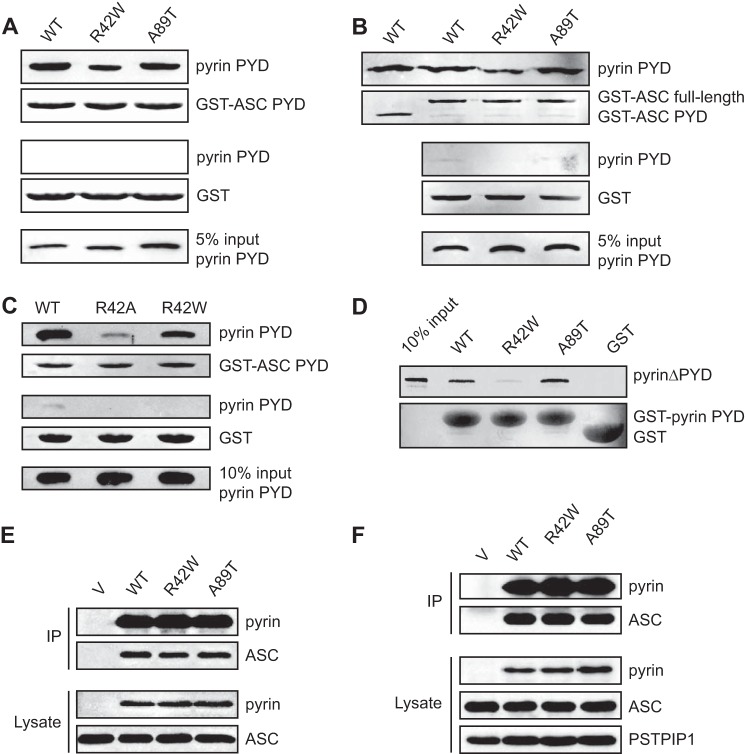FIGURE 9.
FMF-associated mutations in pyrin PYD do not abrogate interaction with ASC. A and B, effect of FMF-associated mutations, R42W and A89T, on interaction of pyrin PYD with ASC PYD (A) or full-length ASC (B). C, comparative effect of the R42A and R42W pyrin PYD mutations on interaction with ASC PYD. In A–C, purified His6-tagged WT and mutant pyrin PYDs were used for in vitro binding assays with bead-bound GST-ASC PYD, GST-ASC (full-length) or GST alone. Bound protein was eluted with SDS-PAGE sample buffer, subjected to SDS-PAGE, and then transferred to a PVDF membrane. GST-ASC PYD, GST-ASC (full-length), and GST alone were detected with Ponceau S stain, whereas His6-tagged WT and mutant pyrin PYDs were detected by immunoblotting with an anti-His antibody. An amount representing 5% (A and B) or 10% (C) of the input of WT or mutant pyrin PYD used for binding studies is shown. D, effect of FMF-associated mutations on interaction between pyrin PYD and B-box domain. A pyrin construct lacking the N-terminal PYD (pyrinΔPYD) was in vitro translated in the presence of [35S]methionine and incubated with bead-bound WT or mutant pyrin PYD fused to GST or with GST alone. Bound proteins were resolved on an SDS-PAGE gel. GST, GST-ASC PYD, and GST-ASC were detected with Coomassie stain, whereas [35S]methionine-labeled pyrinΔPYD was detected by phosphorimaging. An amount representing 10% of the input of 35S-labeled pyrinΔPYD is also shown. E and F, effect of FMF-associated mutations on interaction of full-length pyrin with ASC. Plasmids expressing Myc-tagged WT or mutant pyrin or empty vector (V) were co-transfected with a plasmid expressing ASC into HEK 293T cells. Pyrin was immunoprecipitated (IP) with an anti-Myc antibody 24 h after transfection, and the immunoprecipitated complexes were analyzed by Western blotting. In E, a plasmid expressing FLAG-tagged PSTPIP1 was also co-transfected. Blots were probed with antibodies to ASC and pyrin and with an anti-FLAG antibody to detect PSTPIP1.

